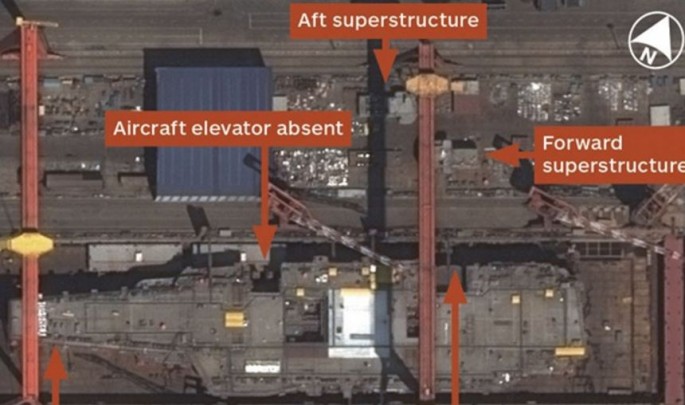China's second aircraft carrier, and the first completely made in China, might become operational by 2020 but will still feature a ski ramp runway that limits combat loads for its Shenyang J-15 stealth jets while also preventing the use of turboprop aircraft.
The ship, identified as CV-17 by the West, is nearing completion at the Dalian Shipbuilding Industry Company in Liaoning that also refurbished the Liaoning (CV-16), China's first aircraft carrier. Liaoning was originally laid down as the Admiral Kuznetsov-class multirole aircraft carrier Riga for the Soviet Navy and was renamed Varyag in 1990. China bought the stripped-down hulk of the Varyag in 1998 and towed it to the Dalian shipyard.
Satellite photographs from an Airbus Defense and Space satellite reveal most major construction on CV-17 is complete. This ship will be the first of the Type 001A class. China plans to build at least three carriers of this class before transitioning to a new class featuring the more efficient catapult launch system used on all 10 Nimitz-class supercarriers of the U.S. Navy.
The satellite photos show the flight deck hasn't yet been installed. The hull, however, is mostly complete. Just one aircraft elevator, superstructure and some deck sections are to be added.
The new carrier might displace 70,000 tons compared to the 100,000 tons for the U.S. Navy Nimitz-class.
It will also carry far fewer aircraft than the Nimitz-class. CV-17 might carry some 48 aircraft including 36 of the troubled Shenyang J-15 multi-role fighters and 12 Changhe Z-18 medium transport helicopters or the Harbin Z-9 utility helicopters.
In comparison, the Nimitz-class can carry up to 90 fixed wing and rotary aircraft.
A weak point of CV-17 is its ski jump launch system. Only jet powered planes such as the J-15 can develop sufficient speed to launch from them. The same can't be said for turboprop aircraft. The ski ramp suggests China hasn't yet mastered the catapult system.
The absence of airborne early warning and cargo turboprop aircraft aboard the CV-17 increases the danger to the carrier from far distant threats.






















